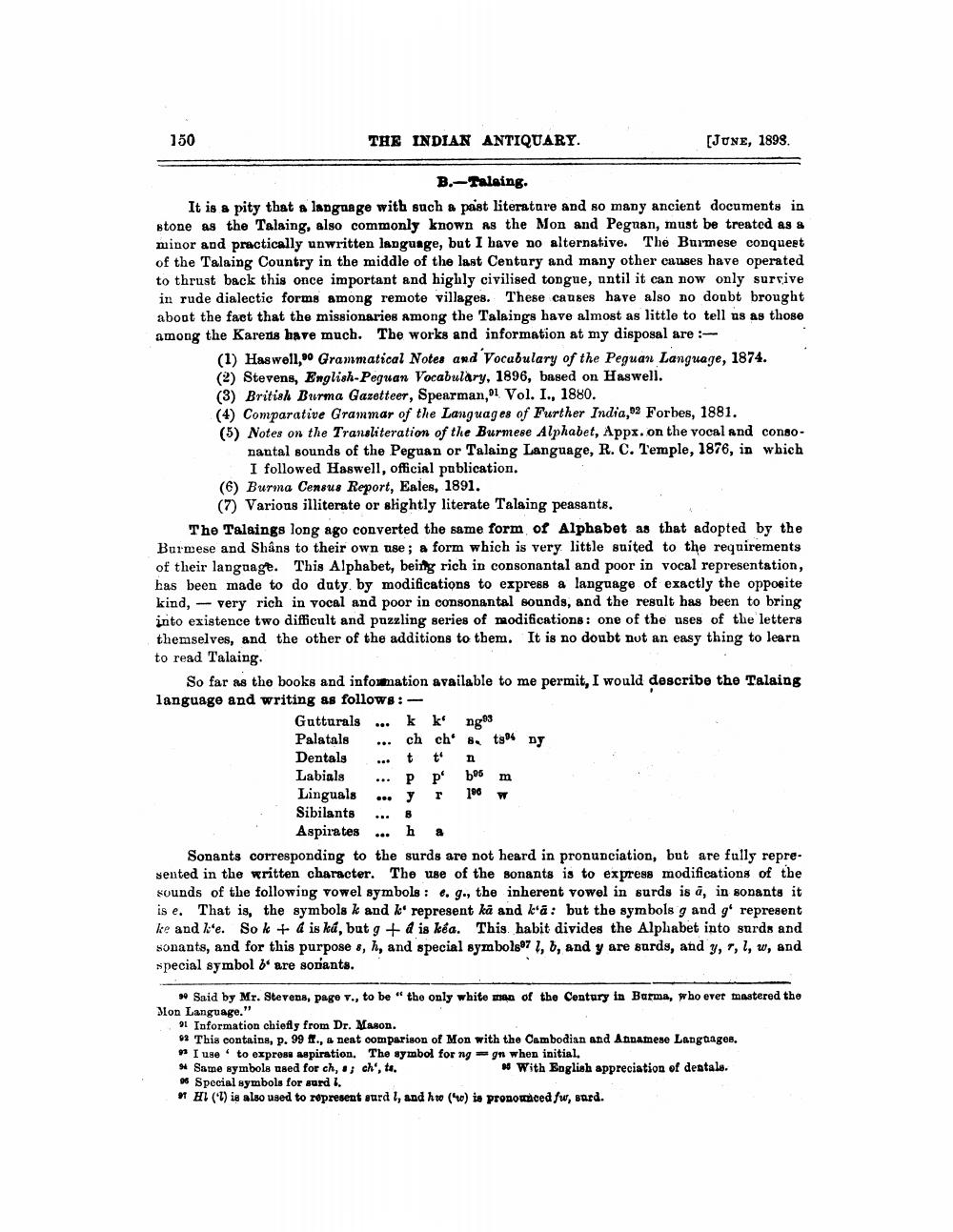________________
150
THE INDIAN ANTIQUARY.
[JUNE, 1893.
B.-falsing. It is a pity that a language with such a past literature and so many ancient documents in stone as the Talaing, also commonly known as the Mon and Peguan, must be treated as a minor and practically unwritten language, but I have no alternative. The Burmese conquest of the Talaing Country in the middle of the last Century and many other causes have operated to thrust back this once important and highly civilised tongue, until it can now only survive in rude dialectic forms among remote villages. These causes have also no doubt brought aboot the fact that the missionaries among the Talaings have almost as little to tell us as those among the Karens have much. The works and information at my disposal are :
(1) Haswell,00 Grammatical Notes and Vocabulary of the Peguan Language, 1874. (2) Stevens, English-Peguan Vocabulary, 1896, based on Haswell. (3) British Burma Gazetteer, Spearman,ol Vol. I., 1880. (4) Comparative Grammar of the Languages of Further India, o2 Forbes, 1881. (5) Notes on the Transliteration of the Burmese Alphabet, Appx. on the vocal and conso
nantal sounds of the Peguan or Talaing Language, R. C. Temple, 1876, in which
I followed Haswell, official publication. (6) Burma Census Report, Eales, 1891.
(7) Various illiterate or slightly literate Talaing peasants. The Talaings long ago converted the same form of Alphabet as that adopted by the Burmese and Shâng to their own use; a form which is very little suited to the requirements of their language. This Alphabet, being rich in consonantal and poor in vocal representation, has been made to do duty by modifications to express a language of exactly the opposite kind, - very rich in vocal and poor in consonantal sounds, and the result has been to bring into existence two difficult and puzzling series of modifications: one of the uses of the letters themselves, and the other of the additions to them. It is no doubt nut an easy thing to learn to read Talaing
So far as the books and infomation available to me permit, I would describe the Talaing language and writing as follows:
Gutturals ... k k ngo Palatals ... ch ch' 8t504 ny Dentals ... tt 1 Labials ... Pp b5 m Linguals ... y r 186 w Sibilants ... 8
Aspirates ... h & Sonants corresponding to the surds are not heard in pronunciation, but are fully represented in the written character. The use of the sonants is to express modifications of the sounds of the following vowel symbols : e. g., the inherent vowel in surds is a, in sonants it is e. That is, the symbols k and k' represent ka and ka: but the symbols g and gi represent ke and le. So k + ais ká, but g + d is kéa. This habit divides the Alphabet into surds and sonants, and for this purpose 8, h, and special symbols97 1, 6, and y are surds, and y, 7, 1, w, and special symbol b' are sonants.
5. Said by Mr. Stevens, page v., to be the only white man of the Century in Barma, who evet mastered the Mon Language."
91 Information chiefly from Dr. Mason. 92 This contains, p. 99 8., a neat comparison of Mon with the Cambodian and Annamese Languages.
I use to express aspiration. The symbol for ng gn when initial, 94 Same symbols used for ch,; ch', ts.
* With English appreciation of dentale. 5 Special symbols for surd 1.
HI (l) is also used to represent stard I, and hro (") is pronounced fw, surd.




